Help the Aged: innovative adaptive reuse in architecture
Text by Alyn Griffiths
London, United Kingdom
18.12.10
'Waste not, want not' is an expression that has become increasingly pertinent in recent years as economic conditions have forced many of us to tighten our belts and make the most of what we have, rather than constantly replacing old with new. This attitude of thrift extends to architecture in the form of adaptive reuse – the conversion of an old building into something better suited to contemporary requirements. Here, we examine some recently completed, ongoing and future projects that show how imagination and intelligent design can deliver striking transformative effects.
Derelict or abandoned buildings often have a great deal to offer in terms of location and character and should be viewed as opportunities rather than eyesores; Dovecote Studio, post-renovation, photo: Haworth Tompkins
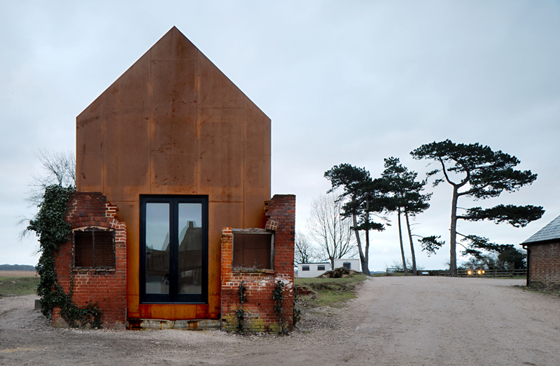
Derelict or abandoned buildings often have a great deal to offer in terms of location and character and should be viewed as opportunities rather than eyesores; Dovecote Studio, post-renovation, photo: Haworth Tompkins
×There are few more wasteful processes than tearing down an existing building and replacing it with something entirely new. Although this, as some might argue, egregious misuse of energy and raw materials still occurs on a regular basis, adaptive reuse has become a popular alternative to demolishing the derelict and disused structures that sit on prime real estate in cities, suburbs and countryside locations around the world. These buildings often represent a faded memory of more settled or prosperous times, and, while not all have outstanding historic or aesthetic credentials, they often make up for it through a character that comes from age and use. Their replacement with modern constructions can remove any legacy and connection with the surroundings, something that intelligent reuse can retain. Although renovation can be costly, it is often cheaper than demolition and reconstruction, and it offers the possibility of securing a premium location by choosing to redevelop a building that is protected by a conservation order and sensitively adapting it.
The Elbphilharmonie by Swiss practice Herzog & de Meuron under construction in Hamburg’s harbour area; photo: Oliver Heissner
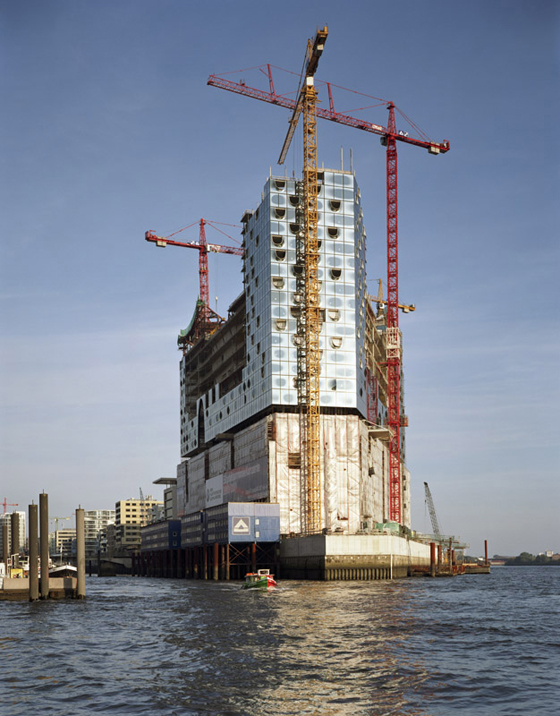
The Elbphilharmonie by Swiss practice Herzog & de Meuron under construction in Hamburg’s harbour area; photo: Oliver Heissner
×There is currently a proliferation of properties ideally suited to adaptation situated in former industrial areas, places which have become redundant as manufacturing has been relocated. These factories, warehouses and docks are often perfect for alternative uses as they are robustly built and grand in scale. As the process of urban sprawl encourages developers to look further from city centres for affordable land, these former temples to industry are taking on new roles as locations for culture, business and urban living.
The Swiss-based practice of Jacques Herzog and Pierre de Meuron has pioneered adaptive reuse for more than a decade. The completion of Tate Modern in London in 2000 – a conversion of Sir Giles Gilbert Scott’s Bankside Power Station on the banks of the River Thames – revolutionised the way in which people viewed the conservation of iconic landmarks and showed that the functionality of a building could be completely overhauled. They performed the same feat with the CaixaForum in Madrid (opened in 2008) and are currently adapting a disused warehouse in Hamburg into a world-leading concert hall and cultural venue that looks set to have an equally transformative effect on its location, both visually and in terms of socioeconomic revitalisation.
Wave-like hatches in the glass façade of Herzog & de Meuron's Elbphilharmonie facilitate natural ventilation; photo: Oliver Heissner
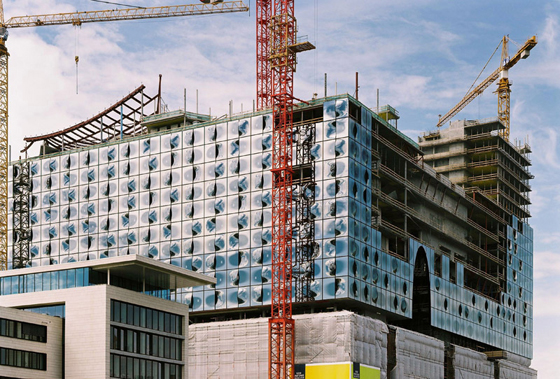
Wave-like hatches in the glass façade of Herzog & de Meuron's Elbphilharmonie facilitate natural ventilation; photo: Oliver Heissner
×The Elbphilharmonie epitomises the aesthetic approach of many contemporary adaptations; the old building juxtaposing starkly against a new addition in a contrasting material. In this case, the red brick warehouse built by Werner Kallmorgen in 1963 acts as a foundation for the new glass extension, emphasizing the relationship between the city’s industrial past and its cultural regeneration. The futuristic construction will house a state-of-the-art concert hall, a hotel, a public plaza 37 metres above the river and 45 apartments, whilst the warehouse will contain parking spaces.
Adapting a building to suit contemporary needs requires an intelligent and sensitive approach to issues and restrictions determined by the dimensions, condition and materials of the existing structure. It is essential to understand what it is possible to save and what needs to be overhauled to ensure the structure is secure and the resultant building will meet modern standards for safety, accessibility, and sustainability. Often the most innovative solutions occur when an architect attempts to renew a building whilst retaining the original footprint and as many features as possible. In this scenario it is necessary to either fit something inside the existing walls or create new space on top of what is already there.
Adding an extra storey on top of the existing structure enabled NHDRO Architects to maximise the potential of this location in Shanghai; photo: © Pedro Pegenaute
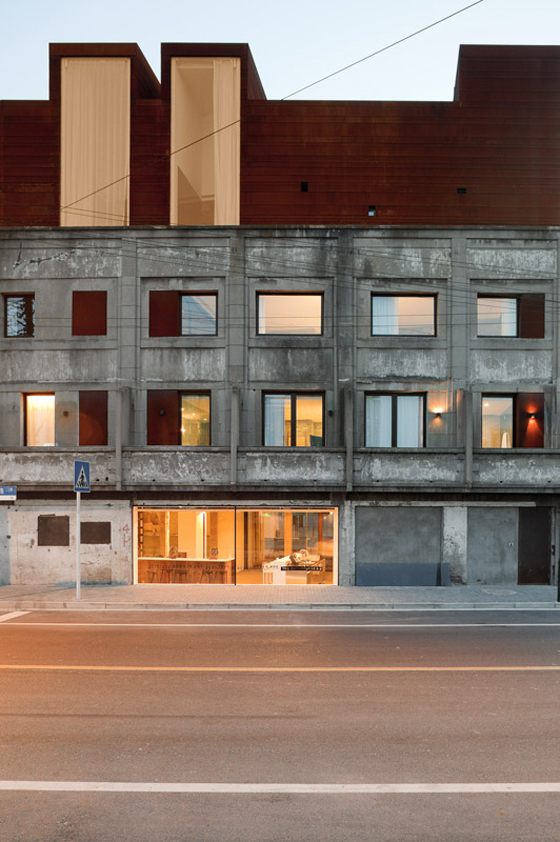
Adding an extra storey on top of the existing structure enabled NHDRO Architects to maximise the potential of this location in Shanghai; photo: © Pedro Pegenaute
×In the South Bund district of Shanghai is a former Japanese army headquarters that has been converted into a boutique hotel by Chinese architecture practice NHDRO. Modern windows replace those from the original concrete building and a fourth storey has been added. This radically contrasting structure made from Cor-Ten steel follows the curved façade of the 1930s building. The extension provides space for additional rooms and incorporates a roof terrace with views towards the Huangpu River.
The Cor-Ten steel structure references the ships that pass along the nearby river; architecture: NHDRO, photo: Derryck Menere
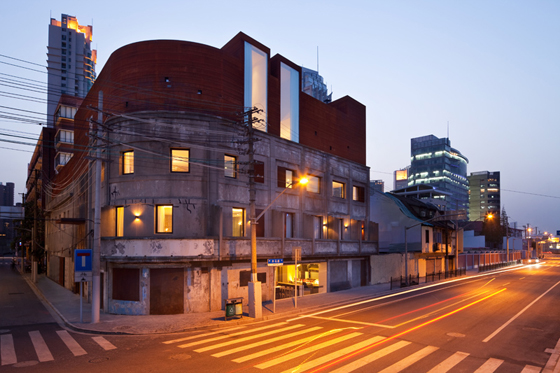
The Cor-Ten steel structure references the ships that pass along the nearby river; architecture: NHDRO, photo: Derryck Menere
×Building upwards has the obvious advantage of offering improved views; in this case, of the Pudong skyline from the new roof terrace; architecture: NHDRO, photo: Derryck Menere
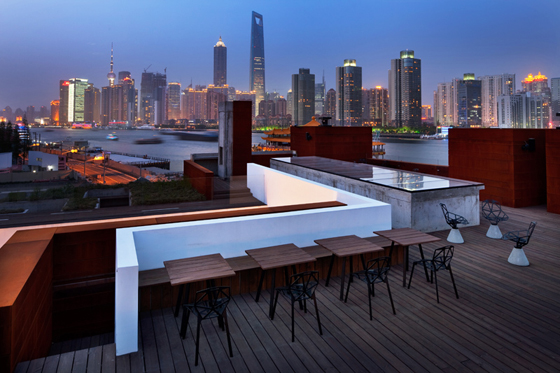
Building upwards has the obvious advantage of offering improved views; in this case, of the Pudong skyline from the new roof terrace; architecture: NHDRO, photo: Derryck Menere
×The decision to add to rather than remove the original structure helps to anchor the hotel in its location, whilst the juxtaposition of concrete and steel reflects the mélange of architectural styles that defines this constantly evolving city. Inside, the impact of time and use on the plaster and brickwork has been turned into a feature that gives great character to the spaces.
The hotel’s interiors confidently combine the peeling plaster and exposed brickwork of the original building with smoothly finished contemporary details; architecture: NHDRO, photo: © Pedro Pegenaute

The hotel’s interiors confidently combine the peeling plaster and exposed brickwork of the original building with smoothly finished contemporary details; architecture: NHDRO, photo: © Pedro Pegenaute
×Where a building has largely retained its structural integrity, the changes needed to alter or enhance its functionality may be relatively minimal. London-based architects Haworth Tompkins recently completed the conversion of a former factory building into a series of painting studios for students at the Royal College of Art. The existing brick building was retained, but its original pitched roof was replaced by a suitably industrial looking saw-toothed steel structure. The angle of the ridges significantly increases the ceiling height and provides north light to the studios, which is ideal for painting.
Haworth Tompkins Architects has transformed a former factory into 'a new machine for painting'; photo: Philip Vile

Haworth Tompkins Architects has transformed a former factory into 'a new machine for painting'; photo: Philip Vile
×An independent steel structure has been inserted on top of the existing brick factory building to create several double-height (7 metres) studio spaces; architecture: Haworth Tompkins Architects, photo: Philip Vile
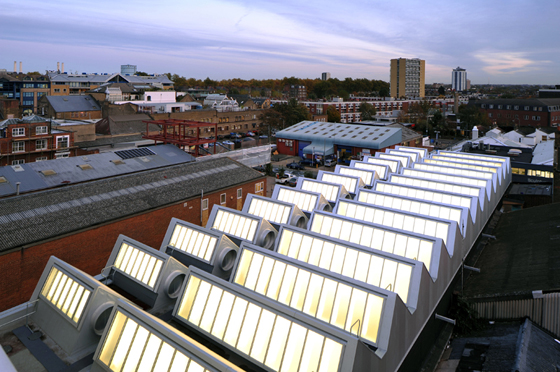
An independent steel structure has been inserted on top of the existing brick factory building to create several double-height (7 metres) studio spaces; architecture: Haworth Tompkins Architects, photo: Philip Vile
×Malcolm Fraser Architects performed a similar trick when they adapted three derelict mews buildings and a Victorian lawyers office in Edinburgh into light and spacious open-plan offices by adding a series of new metal roofs. These additions raise the height of the interior ceiling and provide improved light and ventilation. Similarly shaped apertures in the historic building and the new structure tie the two elements together.
Young Street Lane Offices by Malcolm Fraser Architects is located in a mews street in Edinburgh’s original New Town; photo: David Cemry
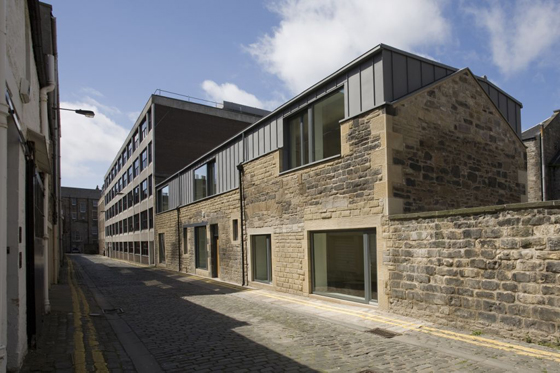
Young Street Lane Offices by Malcolm Fraser Architects is located in a mews street in Edinburgh’s original New Town; photo: David Cemry
×In some cases, the damage to an existing structure can be so severe that it is functionally redundant and beyond restoration. In this scenario, it may still be worth retaining some original features to help to provide consistency with nearby buildings. Fitting a newly constructed shell inside existing walls is one way of giving the space new purpose, whilst maintaining the legacy of its predecessor. In Denmark, Svendborg Architects have adapted an old stable into an artist’s studio by inserting a prismatic volume with an exaggerated pitched roof that directs light into the interior. The contrast between the black finish of the anodized aluminium addition and the white rendered walls of the stable evokes the aesthetic of the surrounding buildings with their traditional thatched and tiled roofs.
Svendborg Architects fitted an independent aluminium structure within the existing walls of this disused stable; photo: Ole Hein
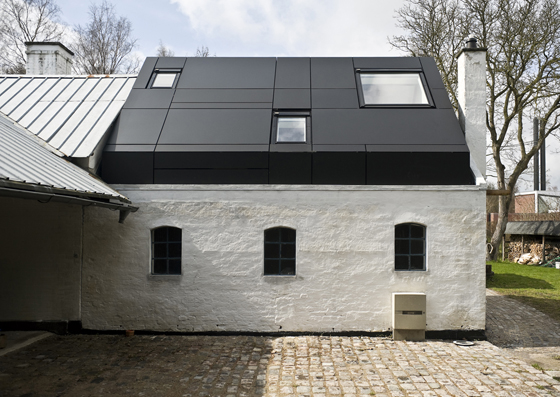
Svendborg Architects fitted an independent aluminium structure within the existing walls of this disused stable; photo: Ole Hein
×The angled roofline and dark finish of the new structure ties in with the other buildings; architecture: Svendborg Architects, photo: Ole Hein
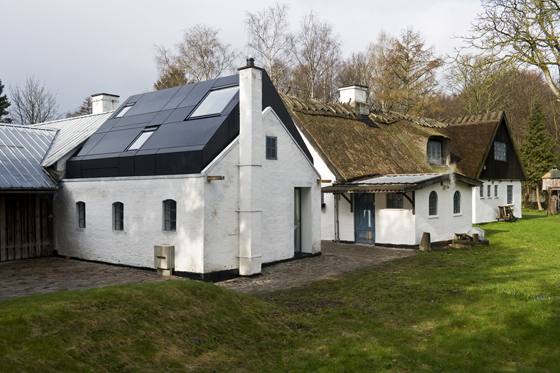
The angled roofline and dark finish of the new structure ties in with the other buildings; architecture: Svendborg Architects, photo: Ole Hein
×A derelict dovecote at the Snape Maltings music campus in Aldeburgh became a small studio and office space for students and staff thanks to the intervention of Haworth Tompkins Architects. The original building was little more than a collection of crumbling, windowless walls into which the architects lowered a prefabricated Cor-Ten steel monocoque. As few repairs as possible were carried out to the existing brickwork and weeds were left growing on the site to continue the natural process of deterioration and decay. The location offers excellent views over the surrounding marshes and by reusing this site the coherence of the original scheme of buildings that make up the former farm is retained.
The rusted hue of the Cor-Ten steel in Haworth Tompkins Architects's Dovecote Studio project is similar to that of the red brick farm buildings nearby; photo: Philip Vile
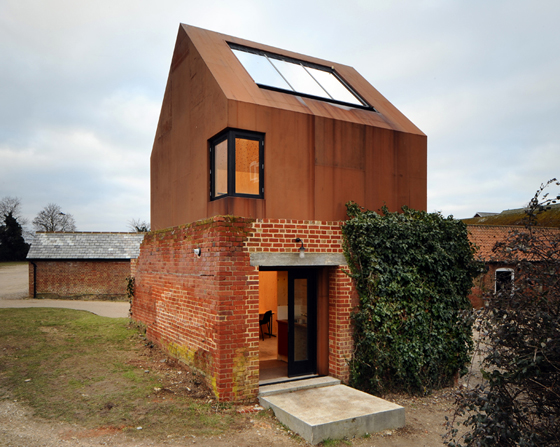
The rusted hue of the Cor-Ten steel in Haworth Tompkins Architects's Dovecote Studio project is similar to that of the red brick farm buildings nearby; photo: Philip Vile
×The steel structure was lowered into place by a crane; architecture: Haworth Tompkins Architects, photo: Philip Vile
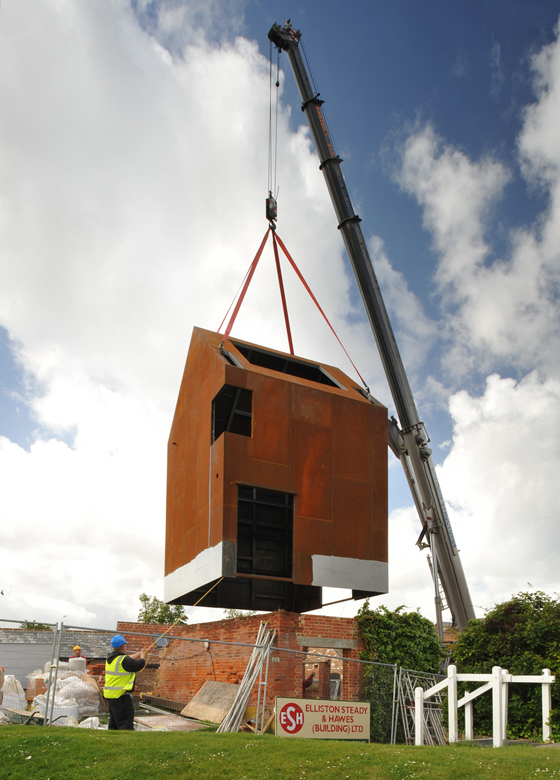
The steel structure was lowered into place by a crane; architecture: Haworth Tompkins Architects, photo: Philip Vile
×Although it is not always the right option, adaptive reuse should be a consideration when looking to create a new space thats meet modern requirements. The potential cost savings and sustainable benefits, combined with visionary designs and the possibility to make use of land in prime locations, should make it an attractive proposition for developers.
The proposed redevelopment of Battersea Power Station will house an event space, offices and a conference centre as well as a green energy plant, making it Europe’s largest carbon-neutral building; architecture and image: Rafael Viñoly Architects
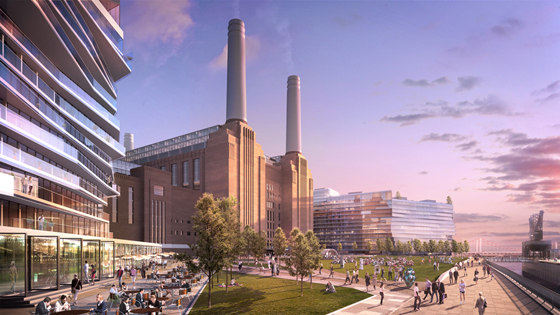
The proposed redevelopment of Battersea Power Station will house an event space, offices and a conference centre as well as a green energy plant, making it Europe’s largest carbon-neutral building; architecture and image: Rafael Viñoly Architects
×The iconic building will be brought back to life and 'will be generating power again, but in harmony with the site and the environment'; architecture and image: Rafael Viñoly Architects

The iconic building will be brought back to life and 'will be generating power again, but in harmony with the site and the environment'; architecture and image: Rafael Viñoly Architects
×There are still many buildings lying dormant, awaiting a transformation that will bring renewed vitality and purpose to the area in which they stand, and few redevelopments are more evocative or eagerly anticipated than that of Battersea Power Station in London. Derelict for a quarter of a century, a masterplan for the regeneration of the power station and the surrounding area by Rafael Viñoly Architects has recently been approved and work should commence in 2012. The proposal could revitalise the area in the same way that Tate Modern did just along the river ten years ago and provide yet another example of the power of making something old new again.















